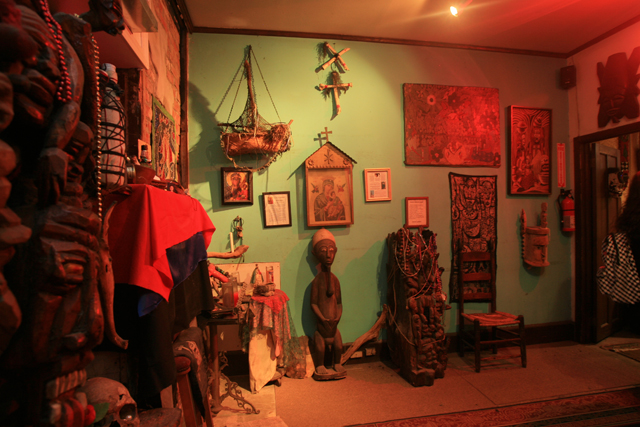Table of Contents
New Orleans pulses with mystical energy, and voodoo spells remain one of the city’s most fascinating spiritual practices. This guide serves travelers, spiritual seekers, and anyone curious about authentic Creole magic who wants to separate fact from Hollywood fiction.
You’ll discover the rich historical roots that shaped New Orleans voodoo into something uniquely different from its African and Haitian origins. We’ll explore the essential ingredients and tools real practitioners use, from gris-gris bags to spiritual oils. You’ll also learn where to find legitimate spell casters and sacred locations throughout the French Quarter and beyond. Voodoo spells in New Orleans.
Most importantly, we’ll cover how to approach this living tradition with proper respect while understanding what modern voodoo practice actually looks like today.
Historical Origins of New Orleans Voodoo Practice
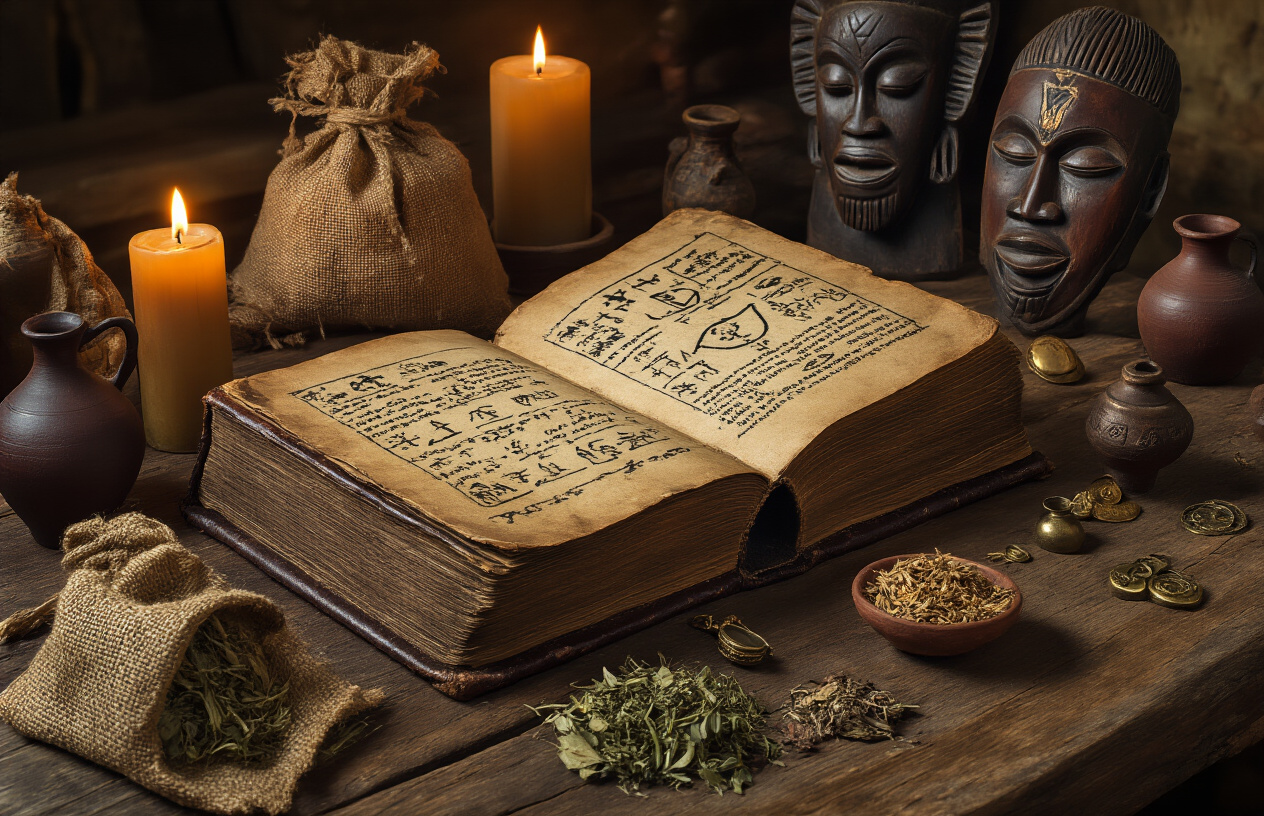
West African Spiritual Traditions and Their Journey to Louisiana
The roots of New Orleans voodoo stretch back thousands of years to the rich spiritual traditions of West and Central Africa. Enslaved people brought with them complex belief systems centered around ancestor worship, spirit communication, and the power of natural forces. These traditions came from various ethnic groups, including the Yoruba, Fon, Kongo, and Ewe peoples, each contributing unique practices and beliefs.
African spirituality emphasized the connection between the living and the dead, with ancestors serving as intermediaries between humans and divine forces. Practitioners believed in a supreme creator deity while also recognizing numerous spirits that governed different aspects of life – love, war, healing, fertility, and protection. Ritual ceremonies involved drumming, dancing, possession by spirits, and the use of sacred objects called gris-gris. Voodoo spells in New Orleans.
When Africans were forcibly transported to Louisiana during the colonial period, they carried these spiritual practices in their hearts and minds. The journey across the Atlantic couldn’t erase centuries of accumulated wisdom about herbal medicine, divination, and spiritual protection. These beliefs became the foundation upon which New Orleans voodoo would eventually develop.
Haitian Influence Through Slave Trade and Immigration
The Haitian Revolution of 1791-1804 brought a massive influx of refugees to New Orleans, fundamentally shaping the city’s spiritual landscape. Free people of color and enslaved Haitians carried with them Vodou practices that had already undergone significant development in Haiti’s colonial environment.
Haitian Vodou had evolved from similar African roots but incorporated elements specific to the island’s experience. The lwa (spirits) of Haitian Vodou became central figures in New Orleans practice, including powerful entities like Papa Legba, Erzulie, and Baron Samedi. These spirits maintained their African characteristics while adapting to new world circumstances.
The Haitian immigrants brought sophisticated ritual knowledge, including elaborate ceremonies, specific drum rhythms, and a detailed understanding of spirit possession. They established the famous Congo Square gatherings where enslaved and free people of color could practice their traditions openly on Sundays. These weekly celebrations became crucial for maintaining and transmitting spiritual knowledge across generations.
| Haitian Contribution | Impact on New Orleans |
|---|---|
| Lwa spirit system | Core pantheon of voodoo spirits |
| Ritual drumming | Congo Square celebrations |
| Possession practices | Spiritual ceremonies |
| Herbal knowledge | Healing traditions |
Catholic Syncretism and Religious Blending
New Orleans voodoo developed its distinctive character through the blending of African spiritual traditions with Catholic imagery and saints. This syncretism wasn’t simply a surface-level adoption of Christian symbols but represented a sophisticated theological adaptation that allowed practitioners to maintain their core beliefs while navigating colonial religious restrictions.
Catholic saints became associated with African spirits based on shared attributes and domains of influence. Saint Peter, keeper of heaven’s keys, merged with Papa Legba, the guardian of crossroads and gatekeeper between worlds. The Virgin Mary found parallels with various female spirits, particularly Erzulie in her different manifestations. Saint Barbara’s association with lightning connected her to African thunder deities.
This religious blending created a unique spiritual system that could operate both within and outside Catholic structures. Practitioners attended Catholic mass while also participating in voodoo ceremonies. Altars combined Catholic imagery with African ritual objects. Prayers might invoke both saints and spirits in the same breath.
The syncretic nature of New Orleans voodoo allowed it to survive and thrive in a predominantly Christian society while maintaining its essential African spiritual core. Voodoo spells in New Orleans.
Marie Laveau’s Role in Popularizing Voodoo Culture
Marie Laveau stands as the most famous figure in New Orleans voodoo history, though separating historical fact from legend proves challenging. Born around 1801, she worked as a hairdresser to wealthy white families, giving her unique access to both elite society secrets and the spiritual needs of diverse communities.
Laveau transformed voodoo from a primarily private practice into a more public phenomenon. She conducted ceremonies at Lake Pontchartrain and Congo Square that drew participants from all racial and social backgrounds. Her reputation for successful spells and spiritual guidance attracted clients ranging from enslaved people seeking freedom to wealthy merchants desiring business success.
Her approach emphasized healing, protection, and practical problem-solving rather than harmful magic. She maintained strong connections to Catholic practice, attending daily mass at St. Louis Cathedral while also serving as a spiritual leader for voodoo practitioners. This dual religious identity helped legitimize voodoo practice in the broader New Orleans community.
Marie Laveau’s legacy includes:
- Establishing voodoo as a recognized spiritual practice
- Creating rituals that combined African, Catholic, and Native American elements
- Building a network of practitioners across racial and class lines
- Popularizing the use of specific ritual objects like red brick dust and black candles
- Developing the tradition of tomb visits and graveyard ceremonies
Her influence extended beyond her death in 1881, with her tomb in St. Louis Cemetery No. 1 becoming a pilgrimage site where people continue to leave offerings and requests for spiritual intervention.
Understanding Different Types of Voodoo Spells
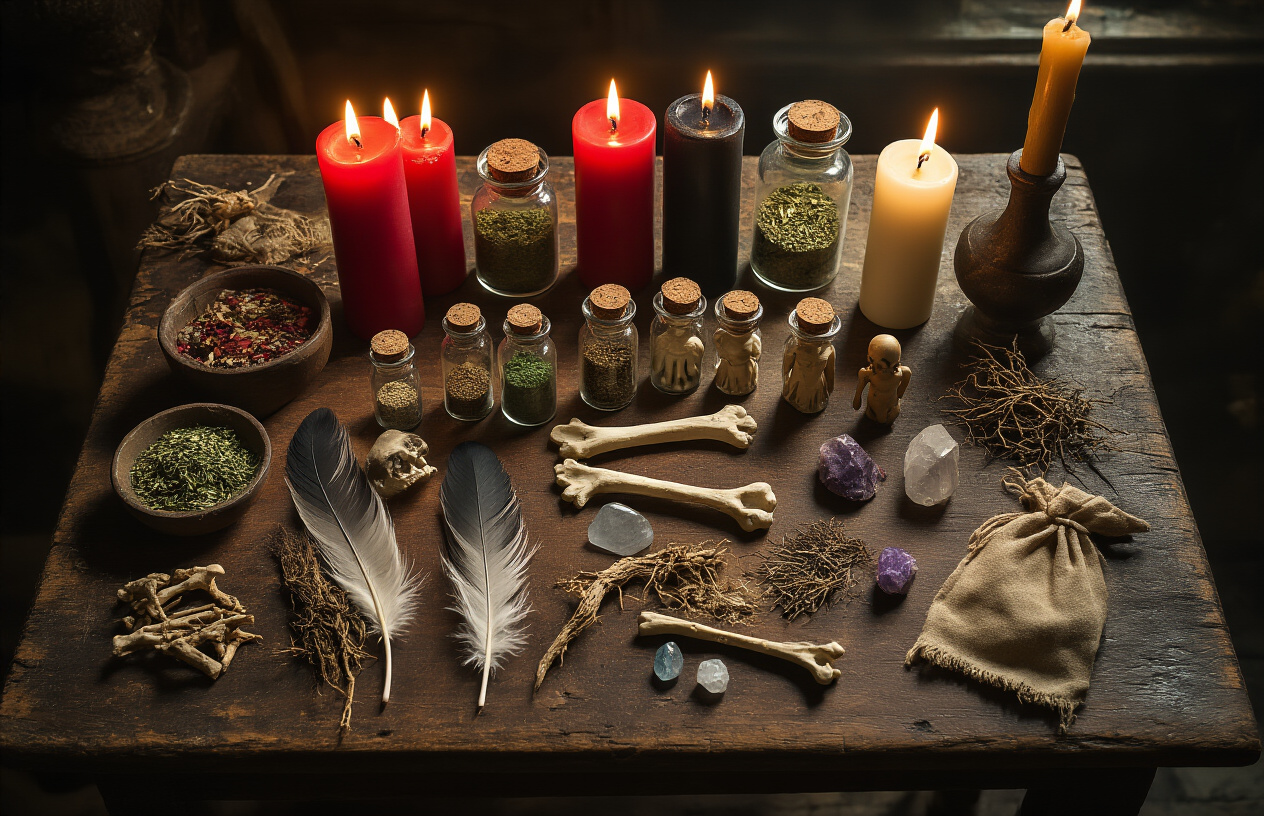
Love and Relationship Attraction Spells
New Orleans voodoo practitioners have long crafted spells designed to kindle romance, strengthen existing bonds, and heal broken hearts. These workings draw upon the spiritual energy of Louisiana’s unique magical traditions, combining African ancestral wisdom with Creole folk practices. Voodoo spells in New Orleans.
The most renowned love spells center around red candles, rose petals, and personal items from the intended target. Practitioners often create mojo bags filled with damiana, rose quartz, and lodestones, which are carried close to the heart to attract romantic energy. The famous “Come to Me” oil, blended with jasmine, patchouli, and cinnamon, gets applied to candles during full moon rituals.
Honey jars represent another powerful technique, where practitioners write names on brown paper, place them in honey along with herbs like vervain and hibiscus, then burn pink or red candles on top. The sweetness symbolically draws love while the sustained flame maintains the spell’s energy.
For relationship healing, practitioners perform “Reconciliation” rituals using paired candles tied together with red thread. Adam and Eve’s root, carried in a red flannel bag, helps restore harmony between estranged lovers. Some spells incorporate photographs placed under lodestones, allowing magnetic properties to pull separated hearts back together.
Protection and Cleansing Rituals
Protection magic forms the backbone of New Orleans voodoo practice, shielding practitioners and their loved ones from negative influences, curses, and spiritual attacks. These rituals create powerful barriers while cleansing away accumulated negativity.
The classic “Fiery Wall of Protection” spell involves creating a circle of red brick dust around one’s property while burning white candles dressed with protective oils. Practitioners sprinkle salt across doorways and windowsills, creating spiritual barriers that malevolent forces cannot cross. Black salt, made by mixing regular salt with charcoal or black pepper, provides extra strength against particularly persistent threats.
Spiritual baths play a central role in cleansing rituals. Hyssop, rue, and Chinese wash mixed with Florida Water remove negative attachments from the aura. Seven-day spiritual baths, performed during the waning moon, gradually strip away layers of accumulated psychic debris. Voodoo spells in New Orleans.
Mirror boxes trap and reflect hexes to their sources. Practitioners place small mirrors facing outward in wooden boxes, then bury them near their homes or carry smaller versions for personal protection. Black candles dressed with reversing oil help turn negative energy away, while white candles blessed with holy water invite positive spiritual guardians.
Gris-gris bags filled with High John the Conqueror root, devil’s shoestring, and iron nails create portable shields. These protective talismans get recharged monthly under the full moon and carried in pockets or purses.
Prosperity and Money Drawing Spells
Financial magic in New Orleans voodoo focuses on opening pathways for abundance rather than simply manifesting cash. These spells work with natural forces to create opportunities, remove obstacles to success, and establish steady income streams.
Green candles form the foundation of most money spells, often carved with dollar signs or the practitioner’s name and dressed with Money Drawing Oil. Five-finger grass, also called cinquefoil, gets sprinkled around the candles to “grab” financial opportunities. Practitioners burn these setups on Thursdays, ruled by Jupiter’s expansive energy.
The famous “Money House Blessing” ritual involves sprinkling blessed rice and coins in the four corners of one’s home or business while reciting prayers for prosperity. Cinnamon sticks placed behind the front door invite wealth to enter, while bay leaves written with specific dollar amounts get burned to release intentions into the universe.
Lodestones paired with magnetic sand create powerful attraction spells for steady income. Practitioners feed these magnetic stones with whiskey and honey while asking for financial blessings. The stones get carried in green mojo bags along with pieces of Devil’s Shoestring root, known for creating lucky breaks in business dealings.
Fast Luck incense, burned before important financial meetings or job interviews, clears away obstacles to success. Some practitioners create “Road Opener” floor washes using lemongrass and eucalyptus to remove blocks preventing money from flowing freely into their lives.
Essential Ingredients and Tools for Spell Casting
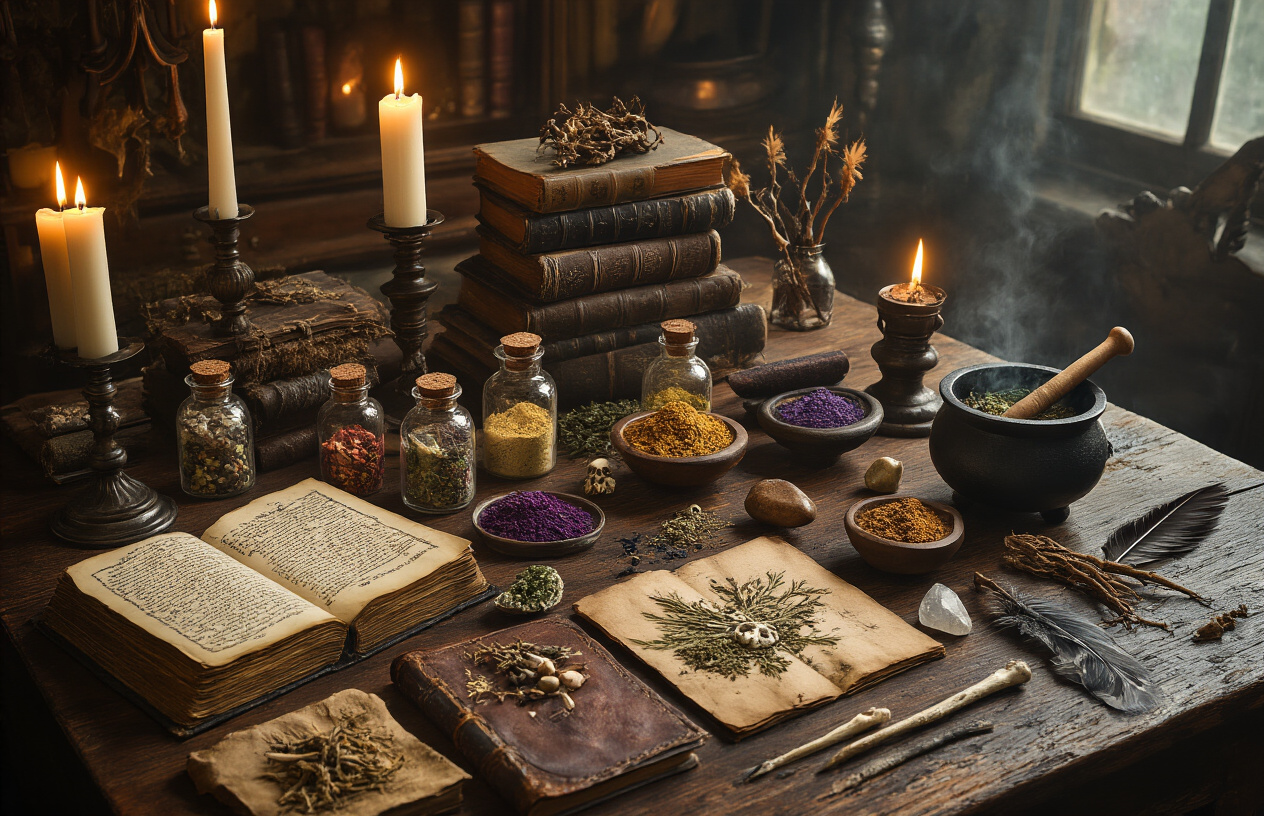
Sacred Herbs and Roots Used in New Orleans Traditions
The heart of New Orleans voodoo lies in the powerful botanicals that practitioners have used for generations. Five-finger grass tops the list as one of the most versatile herbs, traditionally gathered for protection, luck, and blessing spells. Practitioners often combine it with High John the Conqueror root, a gnarled brown root believed to bring personal power and overcome obstacles.
Angelica root serves as a guardian plant, frequently sewn into mojo bags for protection against negative energy. Van Van oil, made from lemongrass, is a staple ingredient for cleansing and drawing good fortune. Spanish moss, draped throughout the city’s ancient oaks, gets collected for love spells and binding work.
| Herb/Root | Primary Use | Collection Method |
|---|---|---|
| Five-finger grass | Protection, luck | Hand-picked at dawn |
| High John root | Personal power | Purchased whole |
| Angelica root | Protection | Dried and ground |
| Lemongrass | Cleansing | Fresh or oil form |
| Spanish moss | Love magic | Gathered respectfully |
Red brick dust, made from grinding old New Orleans bricks, creates powerful protective barriers when sprinkled across doorways and windowsills. Practitioners also rely on cemetery dirt, collected with proper offerings and permissions from the spirits, for various workings involving ancestral connection.
Candles, Colors, and Their Spiritual Significance
Color magic forms the backbone of New Orleans candle work, with each shade carrying specific spiritual vibrations. Red candles burn for passion, love, and courage, while black candles handle banishing negative energy and protection work. White candles serve as all-purpose tools for purification and blessing rituals.
Green candles focus on money magic and healing, making them popular choices for prosperity spells. Blue candles bring peace, wisdom, and spiritual communication, often used when seeking guidance from spirits. Purple candles channel spiritual power and psychic development, while yellow candles attract happiness and mental clarity.
The preparation ritual matters as much as the color selection. Practitioners dress candles with specific oils, rolling them from bottom to top for drawing energy toward you, or top to bottom for sending energy away. Seven-day glass-encased candles, often called “novena candles,” burn continuously for sustained magical work.
Candle placement on the altar follows traditional patterns, with specific colors positioned at cardinal directions. The flame’s behavior during burning provides additional divination – a steady flame indicates smooth progress, while flickering suggests spiritual activity or obstacles.
Gris-gris Bags and Mojo Hands Creation
Gris-gris bags represent portable magic, small fabric pouches filled with herbs, roots, stones, and personal items. The creation process requires careful attention to lunar phases and personal intention. Red flannel fabric traditionally wraps most bags, though color choices depend on the spell’s purpose.
A standard protection gris-gris contains salt, red pepper, a small piece of iron, and angelica root. Love bags might include rose petals, cinnamon, a lodestone, and something belonging to the intended target. Money bags typically hold pyrite, cinnamon, five-finger grass, and a silver coin.
The assembly follows specific patterns – always work with odd numbers of ingredients, traditionally three, five, seven, or nine items. Each ingredient gets added while stating its purpose aloud. The bag gets tied with natural cord, knotted three times while focusing on the desired outcome.
Mojo hands, similar to gris-gris but typically containing more personal elements, require feeding with specific oils or powders to maintain their power. Practitioners often add personal hair, fingernail clippings, or clothing scraps to strengthen the connection between the bag and its owner.
Altar Setup and Sacred Space Preparation
Creating sacred space begins with cleansing the area using burning sage, blessed salt, or floor wash made with spiritual herbs. The altar serves as a focal point for energy work, typically positioned facing east to greet the rising sun’s power.
A white cloth covers the altar surface, with specific items placed according to traditional layouts. A glass of fresh water sits on the left side for spirit communication, while a white candle burns on the right for illumination. Fresh flowers, preferably white or the color matching your spell work, occupy the center position.
Personal items strengthen the altar’s connection to your energy – photographs of ancestors, meaningful jewelry, or stones collected from special places. A small bowl holds offerings for the spirits, often rum, honey, or coins. Incense burns continuously during ritual work, with frankincense and myrrh being traditional choices.
The four directions get acknowledged through specific representations – a feather for air (East), a red candle for fire (South), a bowl of water (West), and salt or stones for earth (North). Some practitioners include Catholic saints’ images, reflecting the syncretic nature of New Orleans voodoo traditions. Voodoo spells in New Orleans.
Regular maintenance keeps the sacred space energetically clean. Weekly cleansing with blessed water, monthly blessing ceremonies, and seasonal deep cleaning help maintain the altar’s spiritual potency. The space should feel welcoming to beneficial spirits while protecting against negative influences.
Authentic Spell Casting Locations and Practitioners
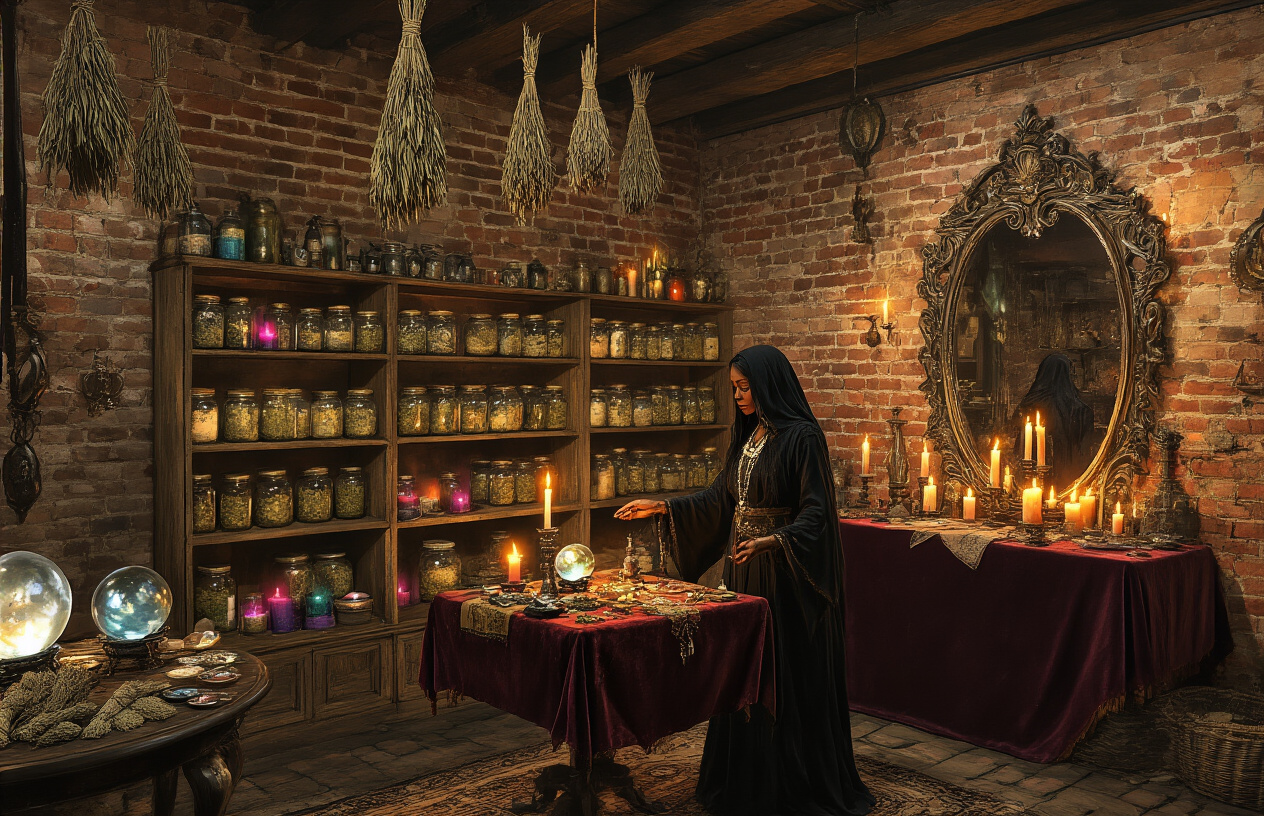
Historic Voodoo Shops in the French Quarter
The French Quarter houses several iconic voodoo shops that have become integral to New Orleans’ mystical landscape. Marie Laveau’s House of Voodoo stands as perhaps the most famous, honoring the legendary Voodoo Queen who dominated 19th-century New Orleans spiritual practices. This shop offers authentic gris-gris bags, ritual candles, and consultation services with experienced practitioners.
The Voodoo Authentic Cultural Center & Collection provides a more scholarly approach, combining retail with educational exhibits about Voodoo’s African roots and Creole evolution. Their practitioners focus on traditional healing and spiritual guidance rather than theatrical performances.
Reverend Zombie’s House of Voodoo brings together serious practice with accessible explanations for newcomers. The shop specializes in custom spell work and houses an impressive collection of ritual tools crafted by local artisans.
| Shop Name | Specialty | Established | Authenticity Level |
|---|---|---|---|
| Marie Laveau’s House | Traditional rituals | 1996 | High |
| Voodoo Authentica | Cultural education | 2003 | Very High |
| Reverend Zombie’s | Custom spellwork | 2004 | High |
Finding Legitimate Voodoo Practitioners and Readers
Distinguishing authentic practitioners from tourist-focused entertainers requires careful observation. Genuine Voodoo priests and priestesses, known as houngans and mambos, typically display deep knowledge of African spiritual traditions, herbalism, and Creole cultural history. Voodoo spells in New Orleans.
Authentic practitioners often require consultation appointments rather than walk-in services. They’ll ask detailed questions about your spiritual needs, family background, and personal circumstances before suggesting any ritual work. Real practitioners emphasize healing, protection, and spiritual growth over dramatic promises or guaranteed outcomes.
Sallie Ann Glassman, a respected white mambo in New Orleans, exemplifies authentic practice through her dedication to Haitian Vodou traditions and community healing work. Priestess Miriam Chamani operates the Voodoo Spiritual Temple, focusing on spiritual counseling and traditional ceremonies.
Look for practitioners who:
- Discuss the spiritual significance behind rituals
- Charge reasonable fees for services
- Emphasize personal responsibility in spiritual work
- Maintain ongoing relationships with clients
- Display genuine ritual items rather than mass-produced novelties
Cemetery Rituals and Sacred Burial Grounds
New Orleans cemeteries serve as powerful spiritual locations where practitioners connect with ancestral spirits and perform memorial rituals. St. Louis Cemetery No. 1 remains the most spiritually significant, housing Marie Laveau’s tomb where devotees still leave offerings and petition for assistance. Voodoo spells in New Orleans.
Cemetery rituals typically involve ancestor veneration, spiritual communication, and energy cleansing. Practitioners bring offerings of rum, cigars, flowers, and coins to honor the spirits dwelling within these sacred spaces. The above-ground tombs, known as “cities of the dead,” create unique spiritual energy due to their proximity and collective presence.
Lafayette Cemetery No. 1 in the Garden District offers quieter spaces for contemplation and ritual work. Many practitioners prefer this location for private ceremonies due to reduced tourist traffic and a stronger spiritual atmosphere.
Proper cemetery etiquette includes:
- Requesting permission from the resident spirits before entering
- Bringing appropriate offerings
- Maintaining respectful silence during rituals
- Cleaning up after ceremonies
- Leaving small tokens of gratitude
Bayou and Natural Setting Ceremonies
Louisiana’s bayous provide ideal settings for water-based Voodoo ceremonies and nature spirit communication. Honey Island Swamp and the Atchafalaya Basin offer practitioners access to powerful natural energies and indigenous plant medicines.
Water rituals in bayou settings often involve spiritual cleansing, healing ceremonies, and communion with water spirits called simbi. Practitioners collect sacred waters, mud, and cypress bark for use in protective charms and healing remedies. Voodoo spells in New Orleans.
Many ceremonies incorporate traditional drumming, singing, and dancing that honor both African ancestors and Native American land spirits. The isolation of bayou locations allows for uninhibited spiritual expression and deeper trance states.
Seasonal ceremonies align with natural cycles:
- Spring rituals focus on renewal and growth
- Summer ceremonies emphasize protection and strength
- Fall practices honor ancestors and harvest spirits
- Winter rituals seek healing and introspection
Bayou practitioners often combine Voodoo with Native American spiritual practices, creating unique syncretic traditions that reflect Louisiana’s multicultural spiritual heritage.
Modern Practice and Cultural Respect
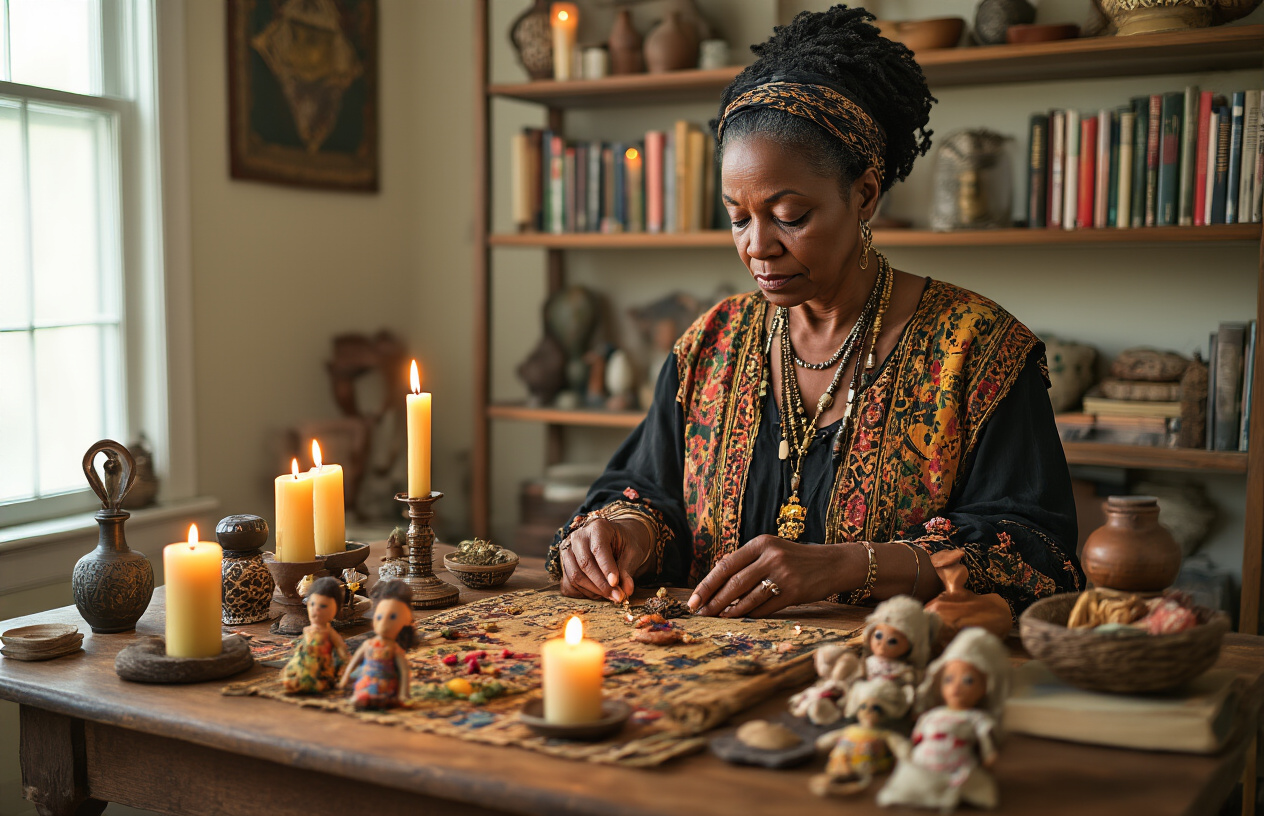
Distinguishing Between Hollywood Myths and Real Traditions
Popular movies and TV shows have created a distorted picture of Voodoo that bears little resemblance to authentic practice. Hollywood’s version typically features dramatic curses, zombie resurrections, and evil practitioners wielding supernatural power for malicious purposes. Real Voodoo traditions center on healing, spiritual guidance, ancestor veneration, and community support. Voodoo spells in New Orleans.
The theatrical elements you see on screen – like dramatic ritual scenes with excessive theatrics – rarely reflect genuine practice. Authentic Voodoo ceremonies focus on spiritual connection rather than spectacle. Practitioners work with spirits called lwa or loa to seek guidance, protection, and healing for themselves and their communities.
Another major misconception involves the concept of “voodoo dolls.” While poppets (small figures) do exist in some traditions, they’re primarily used for healing and positive influence rather than causing harm. The pins stuck in dolls to cause pain is largely a Hollywood invention that has unfortunately become associated with the religion.
Real practitioners emphasize that Voodoo is fundamentally about balance, respect for ancestors, and maintaining harmony between the spiritual and physical worlds. The fear-based portrayals in media have unfortunately contributed to discrimination against practitioners and misunderstanding of this rich spiritual tradition.
Ethical Considerations When Practicing Voodoo Spells
Approaching Voodoo practice requires serious consideration of cultural appropriation and respect for the communities where these traditions originated. This spiritual system developed from the experiences of enslaved Africans who blended their ancestral beliefs with elements they encountered in the Americas. Taking elements without understanding their cultural context or treating them as mere curiosities shows disrespect to people who preserved these practices under extremely difficult circumstances.
Before engaging with any Voodoo practices, spend time learning about the history, the struggles of practitioners, and the cultural significance of rituals. Simply copying spells from books or websites without a deeper understanding misses the spiritual foundation that makes these practices meaningful.
Consider your motivations carefully. Are you drawn to Voodoo for genuine spiritual growth and connection, or are you seeking quick fixes and dramatic results? Authentic practice requires patience, dedication, and respect for the spirits and traditions involved. Voodoo spells in New Orleans.
The concept of reciprocity plays a central role in Voodoo ethics. Practitioners understand that working with spirits creates relationships that involve mutual respect and exchange. Taking without giving back, or approaching spirits with demands rather than requests, goes against fundamental principles.
If you’re not part of the cultural communities where these traditions developed, consider whether your practice honors or exploits these sacred traditions. Supporting authentic practitioners, learning from credible sources, and approaching spirituality with humility show proper respect.
Building Respectful Relationships with the Spiritual Community
Connecting authentically with New Orleans’ Voodoo community requires patience and genuine respect. Begin by visiting reputable spiritual shops, museums, and cultural centers that provide accurate information about the tradition. Many established practitioners offer educational workshops or consultations that provide a proper introduction to the beliefs and practices. Voodoo spells in New Orleans.
Listen more than you speak when engaging with community members. Ask thoughtful questions about history, traditions, and proper protocols rather than immediately seeking spell work or dramatic experiences. Show interest in the cultural context and spiritual philosophy behind the practices.
Support authentic practitioners by purchasing supplies from legitimate spiritual shops rather than generic retailers. These businesses often serve as community centers where you can learn about proper protocols and meet people who share a genuine interest in spirituality.
Attend public ceremonies or cultural events when invited, but remember you’re a guest. Follow dress codes, participate respectfully, and avoid taking photos unless explicitly permitted. Many sacred aspects of Voodoo remain private to protect the tradition from exploitation. Voodoo spells in New Orleans.
Building trust takes time. Authentic practitioners can often sense when someone approaches their tradition with respect versus curiosity or selfish motives. Demonstrate your commitment through consistent, respectful behavior, willingness to learn, and support for the community rather than expecting immediate access to advanced practices.
Consider volunteering with organizations that preserve and educate about African diaspora spiritualities. Contributing your time and energy to protecting these traditions demonstrates a genuine commitment that extends beyond personal spiritual interests.

New Orleans voodoo represents a fascinating blend of African spiritual traditions, Catholic influences, and Creole culture that has shaped the city’s mystical identity for centuries. From love spells using red candles and rose petals to protection rituals involving gris-gris bags and blessed oils, these practices offer insight into a rich spiritual heritage. Finding authentic practitioners and sacred locations like Marie Laveau’s tomb or local botanicas can connect you with genuine traditions passed down through generations.
Remember that approaching voodoo with respect and understanding is crucial. This isn’t about Hollywood dramatizations or tourist attractions – it’s about honoring a living spiritual practice that remains meaningful to many people today. If you’re drawn to explore these traditions, take time to learn about their cultural significance and seek out knowledgeable practitioners who can guide you properly. The magic of New Orleans voodoo lies not just in its spells but in its deep connection to community, healing, and spiritual empowerment.
Also Read:


